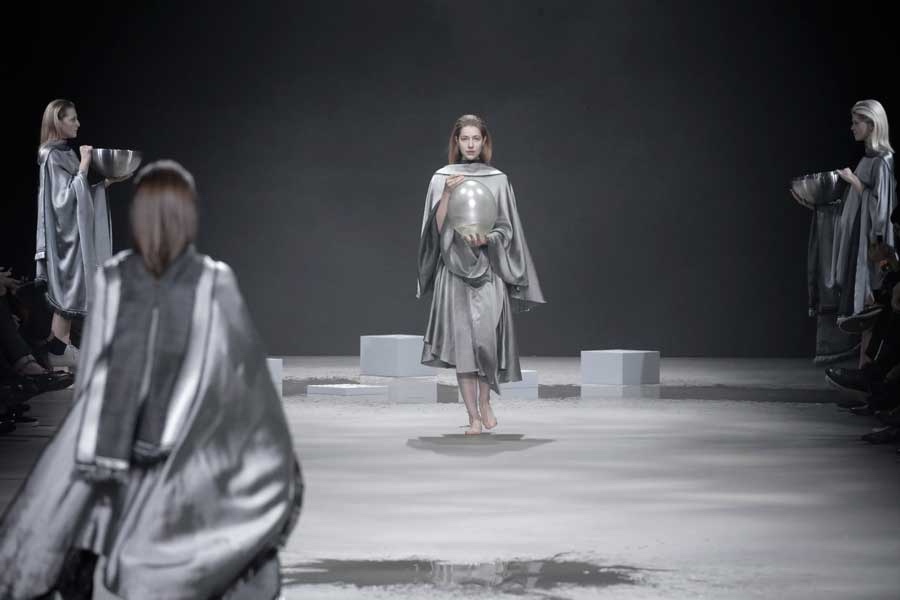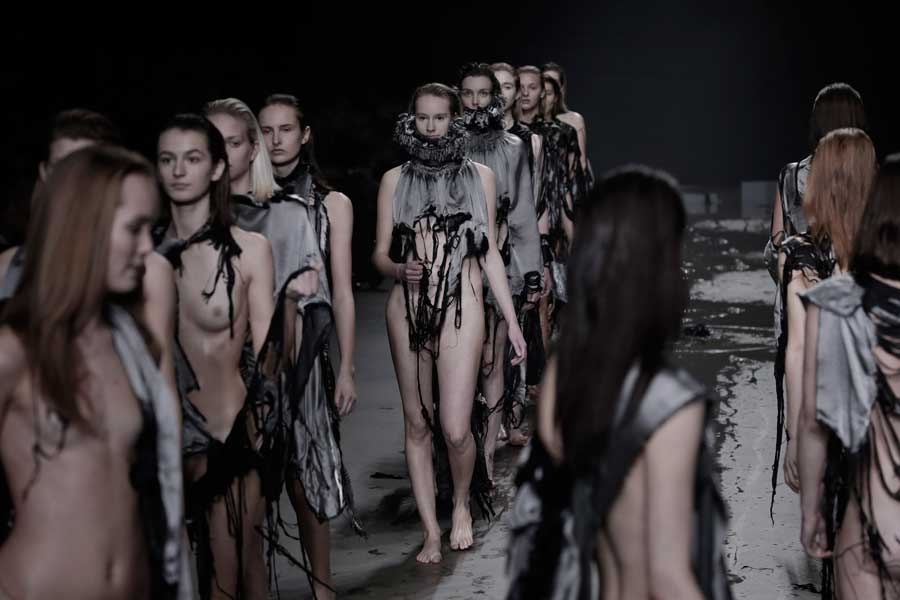All things considered, there are few perils associated with assuming the position in the front row of a catwalk show. An unencumbered view of the entire runway allows an appraisal of the quality of the cut of garments as they pass elegantly by, and a prolonged period to evaluate the models living up to the context of a given show as they walk past in plain sight of scrutinising – but maybe jaded – eyes.
Front row access is one of fashion’s privileges, as being up close and personal to a designer’s technique with fit and finish and wider artistic vision draws in the viewer to the immediacy of what unfolds so closely before them. Being seated directly by the entrance to the catwalk is, under most circumstances, the hottest ticket in a given fashion town, affording as it does a slight glimpse of backstage activity and a yawning panorama once the action commences.
Jef Montes, showing his latest womenswear collection at the autumn / winter 2016 edition of Mercedes-Benz Amsterdam Fashion Week, undoes these ordinary conventions and turns such a vantage point into something of a liability with the aid of our most natural resource. Fashion might decree that substance to be Champagne, but in the less rarefied air of ordinary life, water provides the liquid that greases the wheels of existence.
For ‘Solution’, it is water the designer turns to in order to realise the concept of his collection, while making those situated in the prized seats less glad of their otherwise good fortune, as they participate in the show to an extent that wreaks havoc upon Louboutins prone to the oblivious nature of flowing water. Almost as old as water itself is the aesthetic investigation of the nude, whose formalism has been manifest in painting and sculpture since antiquity.
Nudity is hardly a new phenomena in the fashion arena either, as clothing, in the last analysis, approaches the subject by virtue of concealing – but simultaneously celebrating – the naked body, whose complementary silhouette fashion strives to reveal and improve upon. The delicacy of the contours of the naked body are themselves the canvas upon which artists and designers derive their inspiration. Fashion can treat this topic with the sensitivity nudity deserves, or, in a less dignified manner, as Rick Owens chose to with the peeping penises of his autumn / winter 2015 ‘Sphinx’ show.
Maybe some body parts are best left under wraps, though it is difficult to imagine how the unveiled organ could not fail to appear an unwelcome imposter in an outfit. Montes also chooses not to allow full bodily exposure, as what pass for his dresses – already shredded remnants of cotton and dissolvable yarns which disappear even further once water penetrates the weave – fall away in unpredictable clumps depending on the aim of the models who douse their fellow girls in water thrown from pairs of bowls, which upon contact corrodes the fabric and encourages the randomness of their partially disintegrated form.
Backstage the designer gave a convincing account of his concept and his decision to include a pregnant model. In response to Li Edelkoort’s remark that fashion is dead, Montes encourages the destruction of his collection in keeping with her view, while pondering what remains in the aftermath of fashion drawing its last breath. His answer, implied by the title of this collection, is love, here symbolised by a nakedness revealed by the removal of water-soluble yarn, or a fresh start, as represented by the new life associated with pregnancy, and more abstractly, the balloons filled with water carried by models and burst at various points along the catwalk, so depositing their load and lapping the feet of the front row with it.
Montes’ vision is unflinching, a conviction which must be equalled by the critic’s opinion. No matter your position in the audience, the discomfort of the models was palpable and continuous, from their initial soaking in water we were assured was warm but appeared to be anything but, the hesitancy of their uncertain walking down a catwalk coated in the volatile mixture of water and discarded, soaked material, so making for a slippery and dangerous mush, and the haphazard revealing of the body, which in too many cases to be comfortable led to models rearranging the material just about clinging to their bodies to protect their rapidly disappearing modesty.
The catwalk was barely negotiable come the end of the show, leading to an atmosphere of trepidation on the part of the models that made for awkward viewing. The designer found this a beautiful scene, but one I found veered too closely to amateurish execution – hardly the fault of the models and an environment which made their obligation to walking more dangerous, particularly for the sole pregnant woman, than is surely desirable or relevant to fashion’s relationship with nudity and the body, here made hesitant and ungainly. Though integral to his overall statement – here promoted to the detriment of his collection – the presence of water interpretively and metaphorically diluted the spectacle.
Paul Stewart














